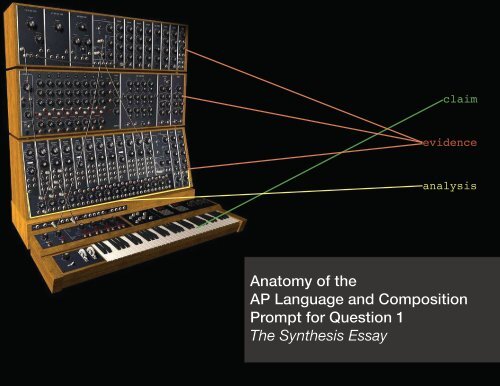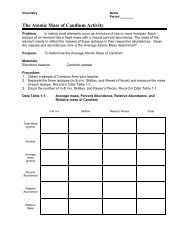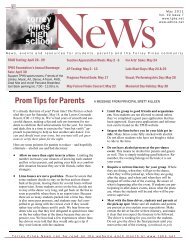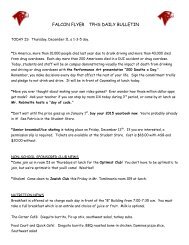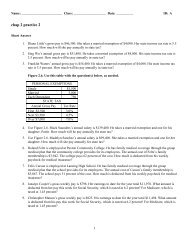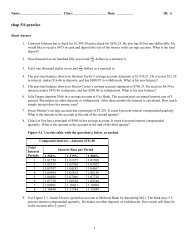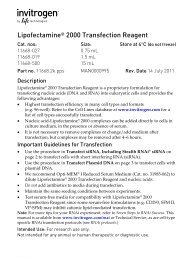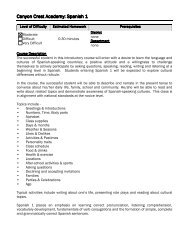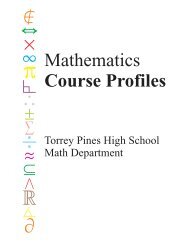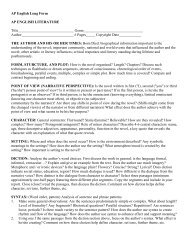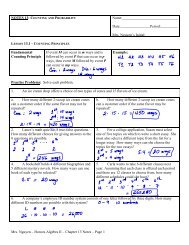Anatomy of the Synthesis Essay Prompt - Teacher
Anatomy of the Synthesis Essay Prompt - Teacher
Anatomy of the Synthesis Essay Prompt - Teacher
You also want an ePaper? Increase the reach of your titles
YUMPU automatically turns print PDFs into web optimized ePapers that Google loves.
claim<br />
evidence<br />
analysis<br />
<strong>Anatomy</strong> <strong>of</strong> <strong>the</strong><br />
AP Language and Composition<br />
<strong>Prompt</strong> for Question 1<br />
The Syn<strong>the</strong>sis <strong>Essay</strong>
<strong>Anatomy</strong> <strong>of</strong> <strong>the</strong> AP ® Language and Composition<br />
<strong>Prompt</strong> for Question 1<br />
The Syn<strong>the</strong>sis <strong>Essay</strong><br />
All Question 1 prompts come in 3 parts.<br />
The Introduction The prompt will begin with <strong>the</strong> context required to complete <strong>the</strong> assignment.<br />
The introduction will give you <strong>the</strong> overview <strong>of</strong> <strong>the</strong> question you are to address,<br />
<strong>the</strong> situation under consideration. The sources will provide you with your evidence.<br />
The Assignment The prompt will <strong>the</strong>n guide you to write <strong>the</strong> essay. The assignment<br />
itself has four parts that we will examine after viewing sample prompts.<br />
The Directions The directions come in three parts and are <strong>the</strong> same for all prompts:<br />
•<strong>the</strong> recommendation Make a single argument, use <strong>the</strong> sources as evidence.<br />
•<strong>the</strong> admonition A reverse-Gaughen: analysis is where <strong>the</strong> points live.<br />
•<strong>the</strong> sourcing method Cite your sources. No real style required, but be clear.
2011 AP ® ENGLISH LANGUAGE AND COMPOSITION<br />
FREE-RESPONSE QUESTION 1<br />
© 2011 The College Board. www.collegeboard.org.<br />
introduction<br />
Locavores are people who have decided to eat locally grown or produced products as<br />
much as possible. With an eye to nutrition as well as sustainability (resource use that<br />
preserves <strong>the</strong> environment), <strong>the</strong> locavore movement has become widespread over <strong>the</strong><br />
past decade.<br />
assignment<br />
directions<br />
Imagine that a community is considering organizing a locavore movement. Carefully<br />
read <strong>the</strong> following seven sources, including <strong>the</strong> introductory information for each<br />
source. Then syn<strong>the</strong>size information from at least three <strong>of</strong> <strong>the</strong> sources and incorporate<br />
it into a coherent, well-developed essay that identifies <strong>the</strong> key issues associated with<br />
<strong>the</strong> locavore movement and examines <strong>the</strong>ir implications for <strong>the</strong> community.<br />
Make sure that your argument is central; use <strong>the</strong> sources to illustrate and support your<br />
reasoning. Avoid merely summarizing <strong>the</strong> sources. Indicate clearly which sources you<br />
are drawing from, whe<strong>the</strong>r through direct quotation, paraphrase, or summary. You may<br />
cite <strong>the</strong> sources as Source A, Source B, etc., or by using <strong>the</strong> descriptions in paren<strong>the</strong>ses.<br />
Source A (Maiser)<br />
Source B (Smith and MacKinnon)<br />
Source C (McWilliams)<br />
Source D (chart)<br />
Source E (Gogoi)<br />
Source F (Roberts)<br />
Source G (cartoon)
2012 AP ® ENGLISH LANGUAGE AND COMPOSITION<br />
FREE-RESPONSE QUESTION 1<br />
© 2012 The College Board. www.collegeboard.org.<br />
introduction<br />
assignment<br />
directions<br />
The United States Postal Service (USPS) has delivered communications for more than two centuries.<br />
During <strong>the</strong> nineteenth century, <strong>the</strong> USPS helped to expand <strong>the</strong> boundaries <strong>of</strong> <strong>the</strong> United States by<br />
providing efficient and reliable communication across <strong>the</strong> country. Between 1790 and 1860 alone, <strong>the</strong><br />
number <strong>of</strong> post <strong>of</strong>fices in <strong>the</strong> United States grew from 75 to over 28,000. With this growth came job<br />
opportunities for postal workers and a boom in <strong>the</strong> cross-country rail system. The twentieth century<br />
brought substantial growth to <strong>the</strong> USPS, including large package delivery and airmail. Over <strong>the</strong> past<br />
decade, however, total mail volume has decreased considerably as competition from electronic mail<br />
and various package delivery companies has taken business away from <strong>the</strong> USPS. The loss <strong>of</strong> revenue<br />
has prompted <strong>the</strong> USPS to consider cutting back on delivery days and o<strong>the</strong>r services.<br />
Carefully read <strong>the</strong> following seven sources, including <strong>the</strong> introductory information for each source.<br />
Then syn<strong>the</strong>size information from at least three <strong>of</strong> <strong>the</strong> sources and incorporate it into a coherent, welldeveloped<br />
essay that argues a clear position on whe<strong>the</strong>r <strong>the</strong> USPS should be restructured to meet <strong>the</strong><br />
needs <strong>of</strong> a changing world, and if so, how.<br />
Make sure your argument is central; use <strong>the</strong> sources to illustrate and support your reasoning. Avoid<br />
merely summarizing <strong>the</strong> sources. Indicate clearly which sources you are drawing from, whe<strong>the</strong>r<br />
through direct quotation, paraphrase, or summary. You may cite <strong>the</strong> sources as Source A, Source B,<br />
etc., or by using <strong>the</strong> descriptions in paren<strong>the</strong>ses.<br />
Source A (Stone)<br />
Source B (graph)<br />
Source C (O’Keefe)<br />
Source D (Hawkins)<br />
Source E (McDevitt)<br />
Source F (Cullen)<br />
Source G (photo)
2008 AP ® ENGLISH LANGUAGE AND COMPOSITION<br />
FREE-RESPONSE QUESTION 1<br />
© 2008 The College Board. www.collegeboard.org.<br />
an older prompt with a slightly different order <strong>of</strong> <strong>the</strong> sections<br />
Directions<br />
The following prompt is based on <strong>the</strong> accompanying six sources. This question requires you to syn<strong>the</strong>size<br />
a variety <strong>of</strong> sources into a coherent, well-written essay. When you syn<strong>the</strong>size sources you<br />
refer to <strong>the</strong>m to develop your position and cite <strong>the</strong>m accurately. Your argument should be central; <strong>the</strong><br />
sources should support this argument. Avoid merely summarizing <strong>the</strong> sources. Remember to attribute<br />
both direct and indirect citations.<br />
Introduction<br />
Some nations have a defined national school curriculum, while o<strong>the</strong>rs, such as <strong>the</strong> United States, do<br />
not. As a result, students in high school English classes in <strong>the</strong> United States can read texts that vary<br />
widely from school to school, while students in o<strong>the</strong>r countries may all read <strong>the</strong> same books in high<br />
school.<br />
Assignment<br />
Read <strong>the</strong> following sources (including <strong>the</strong> introductory information) carefully. Then write an essay that<br />
develops a position on whe<strong>the</strong>r or not <strong>the</strong>re should be specific texts that all students <strong>of</strong> high school<br />
English must read. Syn<strong>the</strong>size at least three <strong>of</strong> <strong>the</strong> sources for support. You may refer to <strong>the</strong> sources<br />
by <strong>the</strong>ir titles (Source A, Source B, etc.) or by <strong>the</strong> descriptions in <strong>the</strong> paren<strong>the</strong>ses.<br />
Source A (Landow)<br />
Source B (Table)<br />
Source C (Greer)<br />
Source D (Book cover)<br />
Source E (Pir<strong>of</strong>ski)<br />
Source F (Fowler)
<strong>the</strong> assignment, unpacked<br />
Careful Reading The prompt will instruct you to read all sources, and to do so carefully - like all prompts<br />
and AP teachers seem to do. Therefore, <strong>the</strong>y mean it. Read <strong>the</strong>m all. You have 15 minutes, so do not stop when<br />
you think you’ve got three bits <strong>of</strong> information you can use. The introductory material is providing exigency for<br />
relevance, reliability, and validity- use it.<br />
• “Carefully read <strong>the</strong> following (number) sources, including <strong>the</strong> introductory information for each<br />
source.”<br />
Evidence The prompt will remind you to provide appropriate evidence. There are two keys in that statement.<br />
Actually provide evidence from <strong>the</strong> sources. And incorporate <strong>the</strong> source information into your essay as evidence<br />
in support <strong>of</strong> your claim. Consider <strong>the</strong> type <strong>of</strong> evidence best suited to <strong>the</strong> argument (form and function)<br />
you are making. Make sure you use three sources. If you have outside evidence, it must be <strong>the</strong> “4th evidence.”<br />
• “Then syn<strong>the</strong>size information from at least three <strong>of</strong> <strong>the</strong> sources and incorporate it...”<br />
<strong>Essay</strong> The prompt will guide you to write an essay... obviously. However, take that seriously. An essay is a<br />
short piece <strong>of</strong> analytical writing. The points live in <strong>the</strong> analysis and you have about 40 minutes. Have a <strong>the</strong>sis,<br />
have claims, but focus on analysis <strong>of</strong> your source evidence.<br />
• “... and incorporate it into a coherent, well-developed essay that ...”<br />
Focus The prompt will give you <strong>the</strong> topic <strong>of</strong> your argument. Each prompt is unique. Some ask you to argue<br />
from a specific position. Some ask you to argue from a certain perspective. Some ask you to conduct a problem<br />
analysis and provide a solution. Note <strong>the</strong> specific form <strong>of</strong> argumentation and <strong>the</strong> topic you will be writing<br />
about. Regardless <strong>of</strong> <strong>the</strong> prompt focus, note that you are to argue.<br />
• “... essay that identifies <strong>the</strong> key issues associated with <strong>the</strong> locavore movement and examines <strong>the</strong>ir<br />
implications for <strong>the</strong> community.”<br />
• “... essay that argues a clear position on whe<strong>the</strong>r <strong>the</strong> USPS should be restructured to meet <strong>the</strong><br />
needs <strong>of</strong> a changing world, and if so, how.”<br />
• “... essay that develops a position on whe<strong>the</strong>r or not <strong>the</strong>re should be specific texts that all students<br />
<strong>of</strong> high school English must read.”


